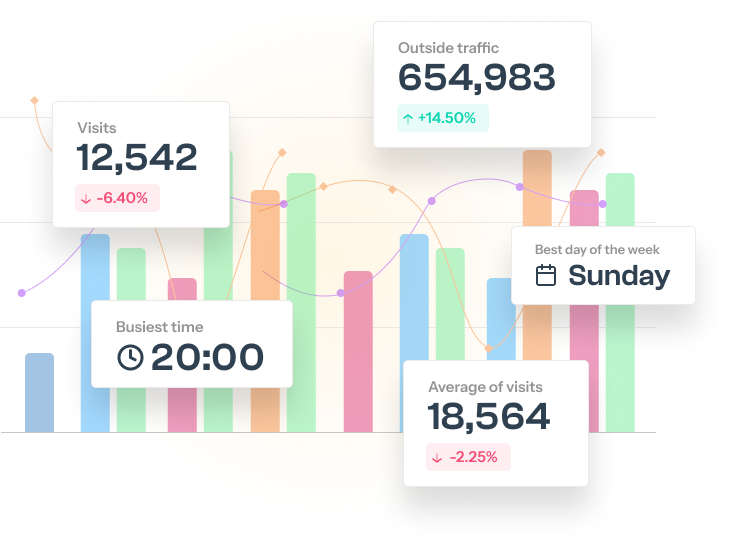Empowering physical spaces with
data intelligence
Flame es una plataforma de analítica avanzada que combina video y una gama de fuentes de datos con Inteligencia Artificial para mejorar la toma de decisiones y el rendimiento de los espacios físicos.














Soluciones basadas en datos para espacios inteligentes
Flame te ayuda a comprender el comportamiento de tus clientes, medir el rendimiento de tus espacios físicos y conectar con tus visitantes para aumentar su fidelidad.
MIDE EL RENDIMIENTO DE TUS ESPACIOS
Mide el tráfico con precisión para optimizar tu negocio
Flame te permite medir el tráfico en todos los puntos del customer journey, incluído el tráfico exterior, las visitas, analítica por plantas y zonas, ocupación, etc. Crea embudos de conversión consistentes y compara diferentes ubicaciones, todo ello enfocado para descubrir las mejores prácticas (a veces ocultas) y mejorar la planificación del staff.


COMPRENDE EL COMPORTAMIENTO DEL CLIENTE
Analiza el flujo de clientes y mejora la experiencia de compra
Comprende el comportamiento de los clientes analizando con precisión su recorrido en el espacio físico y sus movimientos e interacciones en varios puntos del customer journey. Mejora la experiencia del cliente en tus espacios físicos, fidelízalos y potencia tus acciones de marketing.
CONNECT
Conecta con tus visitantes y aumenta su fidelidad
Conecta con los visitantes en tus espacios físicos, obtén su información de contacto y sus consentimientos, y envíales campañas de marketing personalizadas en función de su ubicación, intereses, género, edad o comportamiento.



Descubre el potencial de
HyperSensor
Nuestra tecnología se integra de forma estándar con la infraestructura CCTV existente y también con otras fuentes de datos, incluidos los provenientes de contadores de personas, WiFi y Bluetooth, tratándolos como un sensor unificado. Este enfoque te permite realizar un seguimiento de los visitantes mientras se mueven por tu espacio, respetando su privacidad.


Clientes relevantes que confían en Flame

Irene Cuadrado
Marketing & Specialty Leasing manager ABC Serrano (Savills)
Gracias Flame analytics por acompañarnos en el apasionante reto de ofrecer a nuestros visitantes una experiencia omnicanal total.
Vicente Alemany Climent
Coordinador de Innovación y Marketing, Retail Asset Services en Cushman & Wakefield

Es un placer trabajar con Flame analytics como socio estratégico. Fiabilidad para poder analizar el rendimiento de nuestra tienda. Cash Converters Spain es Innovación.
Manuel Fernández
CIO Transformación Digital - Cash Converters
Poder disponer de una conexión Wi-Fi segura en cualquier zona de los hoteles es una forma de generar confianza, y la rapidez y sencillez de la conexión es un aspecto que los clientes aprecian. Flame nos permite conocer los gustos y exigencias de los clientes y dar en el blanco en nuestras propuestas hacia ellos.
Bernat Real
Director de TI de Hotels VIVA
En las tiendas Pompeii utilizamos Flame analytics a diario y nuestra experiencia con la herramienta es muy buena.
Carlos Mancebo
Director de Ventas y Expansión POMPEII BRAND
Flame es una plataforma muy visual con la que te haces una idea de todo lo que ocurre en nuestros restaurantes. Estamos teniendo una experiencia muy positiva al utilizarlo. En Flame no lo dejamos al azar, sino que nos centramos en clientes concretos.
José Miguel de Miguel Peña
Director de Restaurantes Esplore en ILUNION
Gracias a la tecnología, nuestra red dispone ahora de un sistema capaz de comunicar información valiosa sobre nuestra actividad empresarial. El conocimiento de las intenciones y la actividad de nuestros clientes en nuestras tiendas es un activo intangible para aumentar exponencialmente nuestra rentabilidad.
Jacques Ferrándiz Fuster
Alain Afflelou Coordinador de proyectos web

Los datos proporcionados por Flame nos ayudan a adaptarnos a nuestros clientes, cada vez más exigentes, y a las marcas, que nos demandan cada vez más información. Quieren saber quiénes son los clientes, cuándo vienen, con qué frecuencia vienen, cuánto gastan… Los datos nos ayudan a tomar mejores decisiones y a diferenciarnos de la competencia.
Lucas Madiedo
Director de Transformación Digital - Merlin Properties
Gracias a Flame hemos conseguido retener a nuestros clientes, aumentar el retorno de la inversión (ROI) y mejorar el rendimiento empresarial. Es una herramienta muy visual y muy fácil de usar. Para nosotros, conocer el flujo de movimientos de los clientes, así como su comportamiento, ha sido vital.
Luis Simón
Gerente del CC Plaza Éboli
Destacadas marcas de todo el mundo confían en Flame
Únete a Flame Community
Eventos Flame
Flame organiza la mesa redonda “Transformando el Retail: Datos, IA e Innovación en Centros Comerciales” en LIMITLESS 2025
Sectores

Centros comerciales
Valida tu gestión, mejora la experiencia del cliente y consigue un negocio más rentable.

Retail
Mejora el rendimiento de tu tienda con información clave.

Espacios públicos
Mejora la experiencia del cliente y el rendimiento de tu espacio.

Hoteles
Consigue nuevos clientes y fidelízalos.